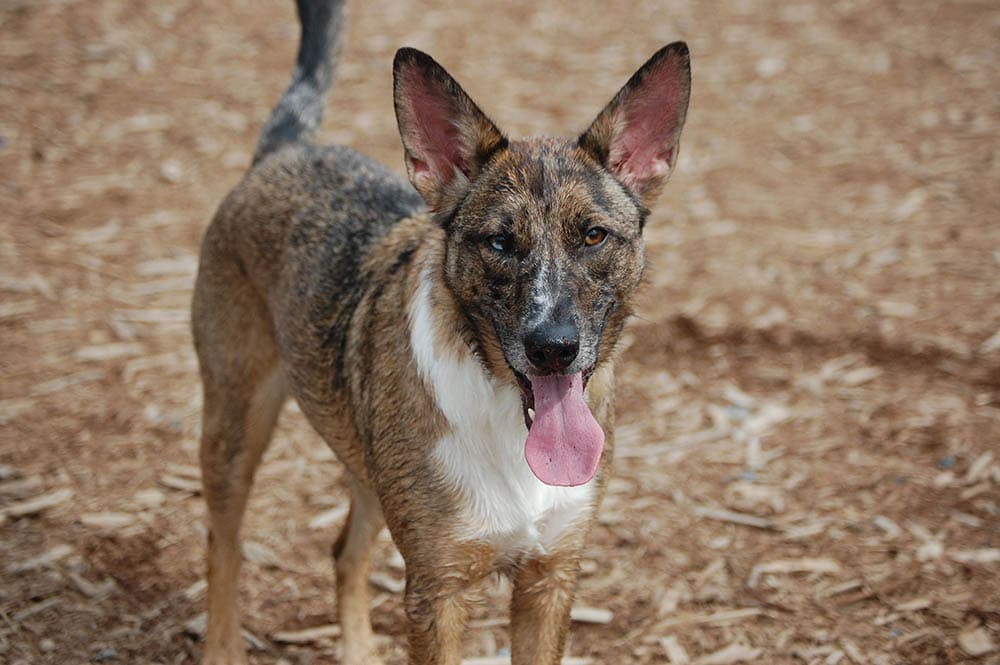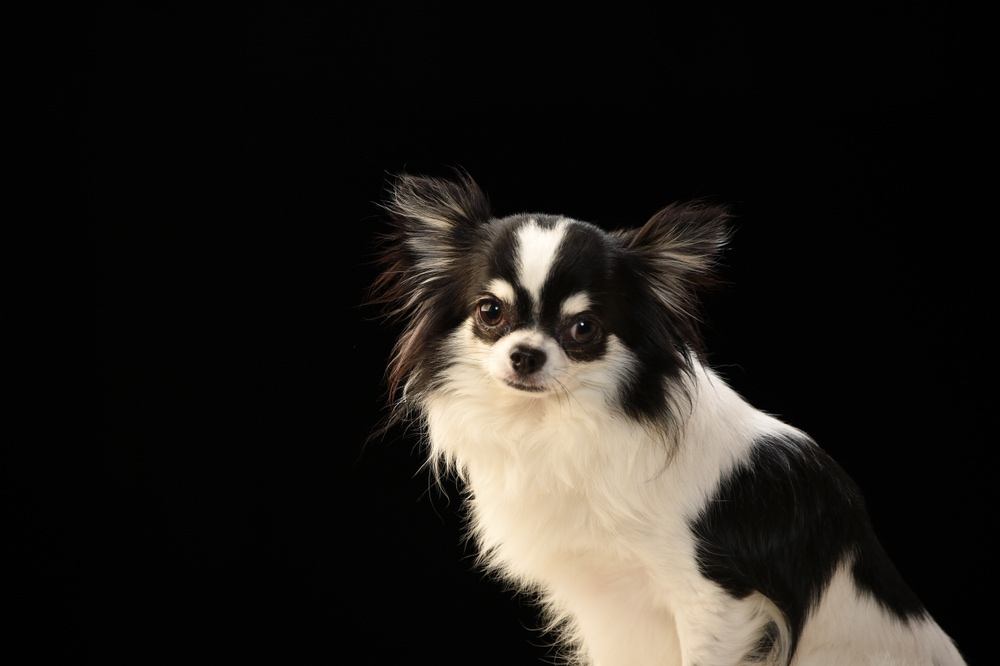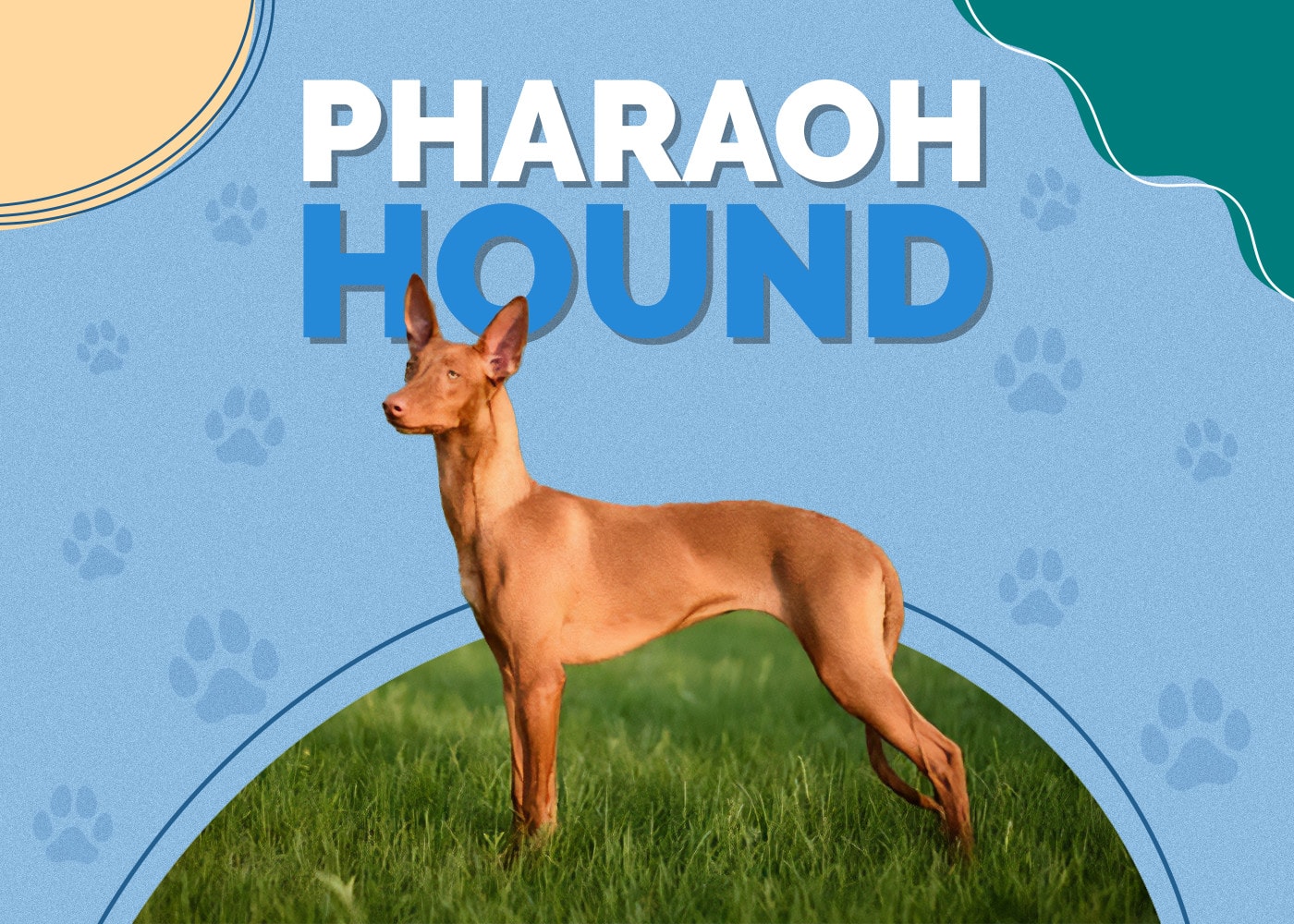Neapolitan Mastiff | Dog Breed Info: Pictures, Traits & Facts

Updated on
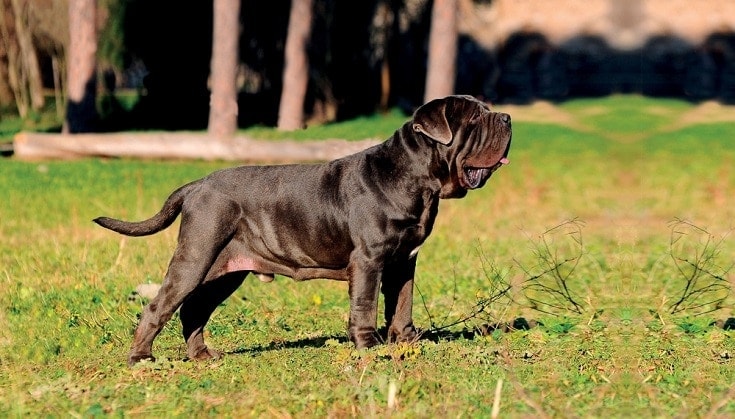
| Height: | 24 – 31 inches |
| Weight: | 120 – 200 pounds |
| Lifespan: | 8 – 10 years |
| Colors: | Black, gray, mahogany, tan, brindle, tawny |
| Suitable for: | Experienced dog families and individuals with no other pets |
| Temperament: | Loyal, affectionate, reserved, strong-willed, quiet |
Intimidating to intruders but a giant teddy bear to the families they protect, the Neapolitan Mastiff is the silent watchdog that many people dream of. Their massive size makes them scary and capable, but their loving temperament and affectionate demeanor toward their family make them lovable companions.
A calm dog overall that rarely ever barks, the Neapolitan Mastiff prefers to lounge around the house and yard rather than spend the day engaged in playtime and other activities. They still need some exercise each day but will prefer a short walk rather than any strenuous activity.
Though they’re affectionate and loving creatures with their family, the Neapolitan Mastiff isn’t a needy dog by any means. They don’t mind being left alone for long periods. When left home by themselves, they’ll simply continue to perform their guard-dog duties by refusing to let anyone near your property.
Of course, if you’re there, your Neapolitan Mastiff will accept anyone you introduce. But they won’t be friendly right away, instead, staying reserved with strangers and acquaintances.
These dogs do best in homes with yards that they can patrol and guard. They don’t need too much space, but they aren’t well-suited for apartments simply due to their massive size.
Neapolitan Mastiff Puppies
When purchasing a Neapolitan Mastiff, there is no such thing as bargain shopping. If you’re looking for a cost-effective dog to add to your family, you’ll need to look at a different breed because this breed doesn’t come cheap.
Neapolitan Mastiffs are susceptible to quite a few health concerns, so you want to make sure you don’t purchase one from a puppy mill where these health concerns will not be taken into account and may be exacerbated through poor living conditions and breeding stock.
When you purchase a Neapolitan Mastiff through a reputable breeder, you can be sure that the breeder has taken care to breed out any known illnesses. Still, you should do your research and ensure they take good care of their pups and are known for producing healthy dogs.
Despite their incredible rarity and high pricing, you can still find Neapolitan Mastiffs available for adoption if you look hard enough. You might need some patience if you want to go this route, but the rewards can be great.
When you adopt a Mastiff instead of buying a puppy from a breeder, you can get a dog that’s already grown out of its destructive puppy stage. Plus, you can save a ton of money over the incredibly high pricing that breeders charge. Finally, you’ll be giving a lucky dog the chance at a great life.
 Temperament & Intelligence of the Neapolitan Mastiff 🧠
Temperament & Intelligence of the Neapolitan Mastiff 🧠
Docile and calm, the Neapolitan Mastiff seems like a gentle giant. To their families, they’re soft as teddy bears. To intruders, they can be dangerous and deadly foes.
At sizes up to 31 inches and weighing up to 200 pounds, the Neapolitan is a lot of dog to hit you if they pounce. That’s what makes them such great guard dogs. Plus, they’re calm demeanor makes sure they’re never jumpy or hyper and they don’t bark unless it’s necessary.
But despite their ability to be dangerous, these are very sweet dogs at heart. They’re very loving and affectionate towards the people they love. You’ll probably find your Neapolitan Mastiff attempting to curl up on your lap like a lapdog, unaware that it weighs as much or more than you do!
Are These Dogs Good for Families? 🏡
Unless you have very small children, Neapolitan Mastiffs make great family pets. They’re so calm and easy-going that they never get riled up. They also don’t display many destructive behaviors and don’t get bored easily since they prefer to lounge for most of the day anyway.
These dogs are known for being great with kids. Older kids might use them as a couch cushion to rest on while watching TV or reading. But the littlest ones will need to be careful. Just by virtue of the Neapolitan’s massive size and clumsiness, they can accidentally knock toddlers down.
- Related Read: Are Mastiffs Good With Kids? Sociability & Training Tips
Does This Breed Get Along With Other Pets? 🐶 😽
Though Mastinis are great with kids, they’re not known for being as good with other pets. They can be aggressive towards other dogs, particularly the males. Plus, they have a pretty strong prey drive that can lead them to chase other pets.
You can help mitigate this issue by socializing your Neapolitan Mastiff constantly and starting at a young age. But you might not eliminate the prey drive and your Mastiff might never be great with other pets.
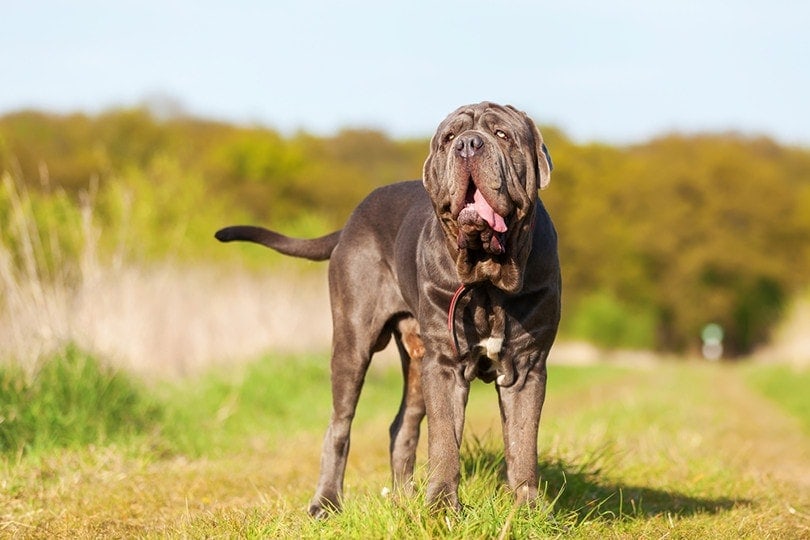
 Things to Know When Owning a Neapolitan Mastiff:
Things to Know When Owning a Neapolitan Mastiff:
Food & Diet Requirements 🦴
It’s no secret that the Neapolitan Mastiff is a massive dog. As such, they need tons of food. Your Neapolitan will eat three or more cups of high-quality dry dog food each day.
You’ll want to measure out the amount you feed your Mastiff each day though. Because they lounge a lot, they can be prone to overfeeding if too much food is offered.
Also, because of their large size and weight, Neapolitan Mastiffs are quite susceptible to joint conditions. You can help reduce the instance of joint problems later in life by supplementing your Neapolitan’s diet with joint supplements like chondroitin or glucosamine.
Exercise 🐕
Most dogs that are around the size of the Neapolitan Mastiff require loads of physical activity each day. But the Neapolitan isn’t as high-maintenance when it comes to exercise.
This large breed only needs 20-30 minutes of physical activity each day in order to stay healthy. But they also prefer to have a sizable yard to roam around in and guard the perimeter of. As such, they’re not the best-suited dogs for apartments or small homes with no yard.
Training 🦮
You might expect the Neapolitan Mastiff to be easy to train since they’re smart and calm. But they’re also stubborn and strong-willed, so you might have a hard time.
It’s recommended that only experienced trainers attempt to take on the training of this breed. With their massive size and propensity for stubborn behavior, it can take a firm hand, lots of patience, and plenty of experience to properly train one of these giants.
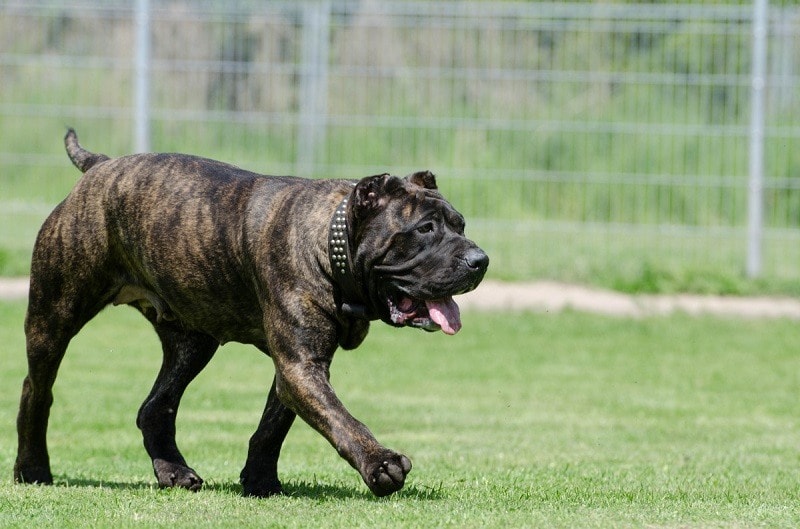
Grooming ✂️
The Neapolitan Mastiff is covered in loose folds of wrinkled skin all over, including the head. They have tons of skin, but their coat is very short and smooth with hairs shorter than an inch in length.
When it comes to the coat, only weekly brushing is necessary to remove loose and dead hair. But because of all the loose skin, you’ll need to clean in the wrinkles and keep them dry. This is especially true of the skin-folds on and around the face. To do this, your Mastiff will require regular bathing and you’ll have to dry them off completely each time.
Health and Conditions ❤️
Big breeds seem to be more susceptible to a variety of health concerns and the Neapolitan Mastiff is no exception. With a pretty short lifespan of just 8-10 years, you’ll also have quite a few health conditions to watch out for as your dog ages.
- Cherry eye: When the third eyelid gland is prolapsed and swollen and turns bright red, it’s called cherry eye. It’s very easy to spot and requires surgical replacement of the third eye gland to correct.
- Cleft Palate: A birth defect that leaves an opening between the mouth and nose. Many puppies with this condition die and others often experience complications like slow growth, difficulty breathing, or infections.
- Demodicosis: All dogs have Demodex mites living on their skin. Usually, it doesn’t affect them. But if the dog’s immune system falters, the mites can multiply and lead to demodectic mange.
- Fold dermatitis: All that loose skin on the Neapolitan Mastiff can be a detriment if your dog gets fold dermatitis in those folds. This is essentially an infection that exists in the pocket between folds of skin, the perfect place for bacteria to grow. Make sure to clean and dry your Mastiff thoroughly and regularly to avoid fold dermatitis.
- Cardiomyopathy: This is a degeneration of the heart muscle that’s most common in large breeds of dog. It develops slowly over time, but may not show itself. When it becomes apparent, symptoms may set in very quickly and congestive heart failure can seem to appear in just a few hours.
- Elbow dysplasia: A collection of abnormalities involving the elbow joint. This condition can result in pain, loss of movement, and even lameness.
- Hip dysplasia: With this condition, the femur and hip grow incorrectly so the femur won’t fit in the hip socket properly. Instead, the femur rubs on the hip bone creating pain, limiting movement, and getting worse with time. There’s no treatment, though the pain can be managed to improve the dog’s quality of life.
Male vs. Female
Male Neapolitan Mastiffs are generally the larger dogs, reaching 31 inches in height compared to the 29 inches that females top out at. Similarly, males occupy the high end of the weight range as well.
As far as temperament, the female Neapolitan Mastiff appears to be more docile while the males tend to exhibit more aggressive behaviors. This is especially true with regard to how they behave towards other dogs. Males tend to be aggressive towards other dogs, particularly other males.
3 Little-Known Facts About the Neapolitan Mastiff
1. They Can Be Traced Back to Alexander the Great
Few breeds have a history as rich and long as the Neapolitan Mastiff. Long ago, Alexander the Great brought giant Macedonian war dogs with him as he conquered the known world. Those beasts were bred with similarly-sized shorthaired dogs from India, creating the Molossus that is the father to many massive modern breeds.
From there, the dogs were used by the Romans in their exploits. When the Romans invaded Britain in 55 B.C., they discovered that the British already had some fierce canine giants of their own. The Molossus and the British dogs were interbred, creating an impressive and gigantic dog that was unmatched as a war animal.
These new dogs were called Mastini, and they were used in war and gladiator battles. They made their way to Naples, Italy, where the breed was slowly improved by breeders over centuries as they guarded the homes of Italian nobles.
But the breed remained very secret until the mid-1940s when one of the rare dogs was spotted at a dog show in Naples. The breed was then standardized and eventually made its way to America in the 1970s.
2. They’re Known for Being Clumsy
It shouldn’t be hard to picture a dog so large being a bit clumsy. At weights up to 200 pounds, when a Neapolitan Mastiff is clumsy, it can cause some serious accidents! They will accidentally knock over chairs, plants, ornaments, and more. Worse, they can accidentally knock over little children without meaning to!
3. Expect a Lot of Drool
With those big hanging dewlaps, all that loose skin, and their gigantic heads, it’s no wonder that the Neapolitan Mastiff drools all over the place. As a Mastini owner, you should expect to find trails of drool everywhere your Mastiff goes. It’ll be most pronounced any time they eat, drink, get warm, get excited, or do pretty much anything. Basically, they drool all the time!
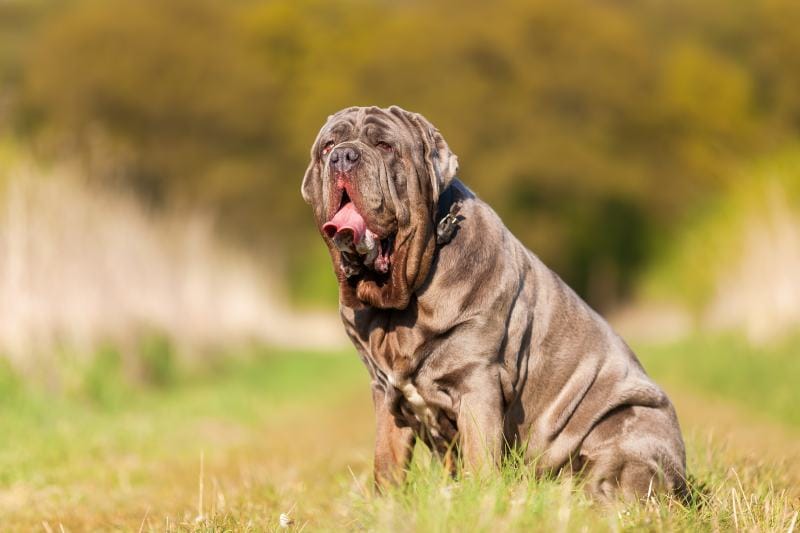
Final Thoughts
With a distinctly wrinkly face, the loving demeanor of a companion pet, and the size of a small bear, the Neapolitan Mastiff is a unique breed of dog. They make excellent guard dogs due to their calm, silent nature and powerful body that can easily take down any type of intruder.
Their giant size makes them special, but with their clumsiness, it can also make them a bit of a liability. Don’t leave your expensive heirlooms on a low shelf where your Neapolitan can accidentally knock it off! Likewise, be careful with small children around this giant dog.
They don’t need much grooming, but you’ll need to keep their skin folds clean. Where you’ll spend the most time maintaining this breed is in cleaning up after their drool!
If you’re looking for a loving family member that doesn’t need much exercise or attention and can guard the house while you’re gone, then the Neapolitan Mastiff is an excellent choice to consider.
See also:
- Kishu Ken | Dog Breed Info, Pictures, Facts & Characteristics
- Great Danebull (Bull Terrier & Great Dane Mix): Info, Pictures, Traits
Featured Image Credit: Ricantimages, Shutterstock

 Temperament & Intelligence of the Neapolitan Mastiff
Temperament & Intelligence of the Neapolitan Mastiff  Things to Know When Owning a Neapolitan Mastiff:
Things to Know When Owning a Neapolitan Mastiff:

